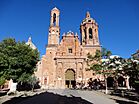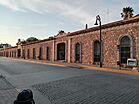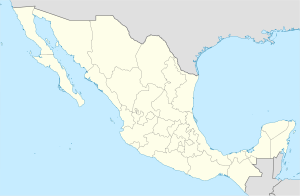Guadalupe, Zacatecas facts for kids
Quick facts for kids
Guadalupe
|
|||
|---|---|---|---|
|
Top: Panoramic view of Guadalupe; middle: Convent of Our Lady of Guadalupe (left) and Cones of Santa Monica (right); Museum of Guadalupe (left) and Seat of Municipal Government (right).
|
|||
|
|||
| Motto(s):
Historia, Trabajo, Progreso
(History, Labor, Progress) |
|||
| Country | |||
| State | Zacatecas | ||
| Municipality | Guadalupe | ||
| Elevation | 2,334 m (7,657 ft) | ||
| Population
(2020)
|
|||
| • Total | 170,029 | ||
| Time zone | UTC-6 (CST) | ||
| • Summer (DST) | UTC-5 (CDT) | ||
| Area code(s) | 492 | ||
| Climate | BSk | ||
| Website | https://gobiernodeguadalupe.gob.mx/ | ||
| UNESCO World Heritage Site | |||
| Official name | Camino Real de Tierra Adentro | ||
| Criteria | Cultural: ii, iv | ||
| Inscription | 2010 (34th Session) | ||
Guadalupe is a city in the state of Zacatecas, Mexico. It is located in the central part of the state. Guadalupe is the most populated city in Zacatecas, with about 170,029 people living there. It forms a larger city area with the nearby city of Zacatecas.
Guadalupe has received several important titles. In 2010, a part of the city, the former Apostolic College of Propaganda Fide of Our Lady of Guadalupe, became a UNESCO World Heritage Site. This was because of its beautiful buildings and its role in spreading the Christian faith in New Spain. In 2015, Guadalupe was officially named a "Historical City." Later, in 2018, it joined the "Pueblos Mágicos" (Magical Towns) program, which celebrates towns with special natural beauty, cultural richness, or historical importance.
Contents
History of Guadalupe
Early History: Before the Spanish Arrived
Before the Spanish came to Mexico in 1546, the land where Guadalupe now stands was mostly used for hunting. Small groups of people, like the Zacatecos and Guachichiles, lived here. They moved around and gathered fruits and hunted animals.
Spanish Rule: The Viceroyalty of New Spain
After silver was discovered in Zacatecas in 1546, people started settling in the Guadalupe area. They built large farms called haciendas, ranches, and orchards. These places provided food and livestock to the growing city of Zacatecas.
Since there wasn't a single official founding date, the city's beginning is linked to the first land ownership records. One of the earliest records is from 1555. Pedro de Ahumada Sámano received land near Zacatecas, which became known as San Nicolás de los Campos.
Later, in 1677, a chapel dedicated to Our Lady of Carmel was given up for a new church. This new church was built for Our Lady of Guadalupe, similar to a famous one in Mexico City.
The Apostolic College
The Franciscans, a group of Catholic priests, built a hospice (a type of shelter) near the chapel. It was named Our Lady of Guadalupe. In 1707, they founded the Apostolic College of Propaganda Fide of Our Lady of Guadalupe. This college became very famous. It was a center for spreading the Christian faith across a large part of northern New Spain and even into what is now the southern United States.
The 19th Century: Independence and New Beginnings
Guadalupe played a role during the Mexican War of Independence. From January to February 1811, Miguel Hidalgo y Costilla, a key leader of the independence movement, stayed in Guadalupe for 10 days. This visit even inspired a famous Mexican folk song called "Las Mañanas de Hidalgo."
A local hero named José María Rodríguez also fought for independence. He was captured and executed in 1814 for trying to help the rebels take the capital city.
In 1821, Guadalupe officially became a City Council. This meant it had its own local government. Although this status changed a few times, it was firmly re-established as a City Council in 1829. In 1845, Guadalupe was given the title of "Villa de Guadalupe de Rodríguez."
Even a Mexican president, Benito Juárez, stayed in Guadalupe in 1867 during a difficult time for his government.
The 20th Century: Revolution and Modern Governance
During the famous Capture of Zacatecas in 1914, Guadalupe was an important escape route for the federal army. Many soldiers were defeated there.
In October 1914, Guadalupe was also the meeting place for troops led by Emiliano Zapata (Zapatistas) and Pancho Villa (Villistas). This meeting happened before the important Convention of Aguascalientes, which tried to unite different revolutionary groups.
In 1915, Guadalupe became a "free municipality." This means it gained administrative independence and could govern itself without needing an intermediate authority between its local council and the state government. This status has continued to this day.
See also
 In Spanish: Guadalupe (Zacatecas) para niños
In Spanish: Guadalupe (Zacatecas) para niños










